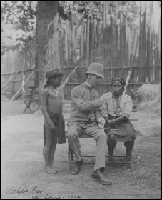|
|
| Director, Script, Photography, Editing, Producer: Marlon Fuentes Music: Doug Quin Sound: Aaron Levinson Appearances: Marlon Fuentes, E.Obusan Source: Marlon Fuentes 630 N. Tustin Ave. #576 Orange, CA 92867 USA Phone & Fax: 1-714-744-6315 e-mail: mfuentes@compuserve.com USA-PHILIPPINES / 1996 / English / B? / 16mm / 57 min |
Philippine-born filmmaker, photographer, and conceptual artist. After attending De La Salle University in Manila, he did his graduate work at the University of Pennsylvania and Temple University's Film and Video program. His work has been shown in over sixty exhibitions over the last 15 years. It is represented in the Smithsonian Institution's National Museum of American Art and other prestigious art institutions around the U.S. As filmmaker, his work follows new terrain uncovered by his previous investigations in photography. Sleep With Open Eyes is an "autobiographical trance film." Other works include Tantalus, Arm, and Crikee. |
 |
|
| Fusing history, memory, and imagination, Bontoc Eulogy explores the complex psychological territory of the Filipino experience at the St. Louis World's Fair of 1904. Experiences of the filmmaker, a Filipino immigrant in America, and the Igorot warrior held captive on show as one of the "primitive men" overlap with each other, stimulating a discourse on power and discrimination. | |
|
|
|
|
Director's Statement The history of the Philippines, a colonial and post-colonial subject, is by default a history of a continuous attempt at self-definition. The 1904 St. Louis World's Fair is a critical historical juncture (i.e, the end of the Spanish colonial era, the end of the Philippine American War, the formal enunciation of American Manifest Destiny on the Filipino subject) where the underlying grid of colonial politics becomes visible on a scale never seen before. It was the sublime syncretic landscape, a living diorama that played out the Other's role in a master narrative of Progress and Civilization. Here, spectacle meets ideology and science: from savage Bontoc Igorot to "assimilatable" Tagalog lowlander, the Philippine specimen was displayed as malleable raw material for the inevitable project of Empire. The unexpected conflict between what we expect and what we see can sometimes bring us back to the consciousness of our own act of perceiving. In Bontoc Eulogy, I want to foreground the oscillation between history and imagination, between the patina of ethnographic nostalgia and the Brechtian disruptions to this surface, between illusion and anti-illusion. |
|
